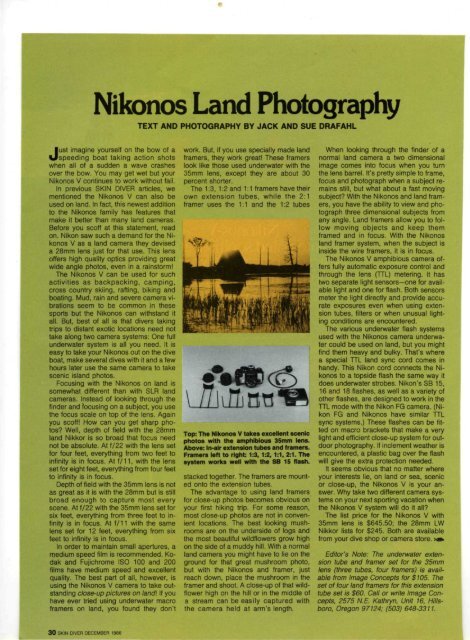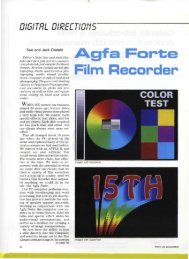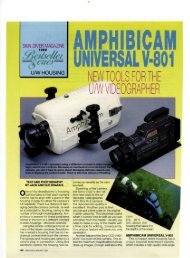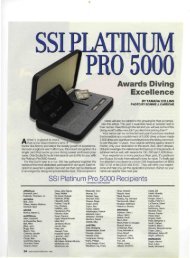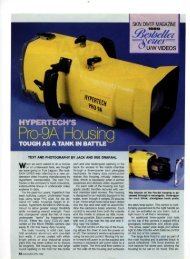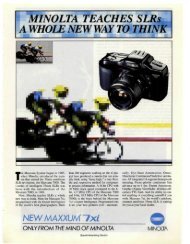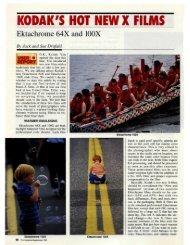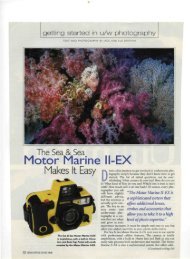Nikonos Land Photography - Jack and Sue Drafahl
Nikonos Land Photography - Jack and Sue Drafahl
Nikonos Land Photography - Jack and Sue Drafahl
You also want an ePaper? Increase the reach of your titles
YUMPU automatically turns print PDFs into web optimized ePapers that Google loves.
<strong>Nikonos</strong> <strong>L<strong>and</strong></strong> <strong>Photography</strong><br />
TEXT AND PHOTOGRAPHY BY JACK AND SUE DRAFAHL<br />
Just imagine yourself on the bow of a<br />
speeding boat taking action shots<br />
when all of a sudden a wave crashes<br />
over the bow. You may get wet but your<br />
<strong>Nikonos</strong> V continues to work without fail.<br />
In previous SKIN DIVER articles, we<br />
mentioned the <strong>Nikonos</strong> V can also be<br />
used on l<strong>and</strong>. In fact, this newest addition<br />
to the <strong>Nikonos</strong> family has features that<br />
make it better than many l<strong>and</strong> cameras.<br />
Before you scoff at this statement, read<br />
on. Nikon saw such a dem<strong>and</strong> for the <strong>Nikonos</strong><br />
V as a l<strong>and</strong> camera they devised<br />
a 28mm lens just for that use. This lens<br />
offers high quality optics providing great<br />
wide angle photos, even in a rainstorm!<br />
The <strong>Nikonos</strong> V can be used for such<br />
activities as backpacking, camping,<br />
cross country skiing, rafting, biking <strong>and</strong><br />
boating. Mud, rain <strong>and</strong> severe camera vibrations<br />
seem to be common in these<br />
sports but the <strong>Nikonos</strong> can withst<strong>and</strong> it<br />
all. But, best of all is that divers taking<br />
trips to distant exotic locations need not<br />
take along two camera systems: One full<br />
underwater system is all you need. It is<br />
easy to take your <strong>Nikonos</strong> out on the dive<br />
boat, make several dives with it <strong>and</strong> a few<br />
hours later use the same camera to take<br />
scenic isl<strong>and</strong> photos.<br />
Focusing with the <strong>Nikonos</strong> on l<strong>and</strong> is<br />
somewhat different than with SLR l<strong>and</strong><br />
cameras. Instead of looking through the<br />
finder <strong>and</strong> focusing on a subject, you use<br />
the focus scale on top of the lens. Again<br />
you scoff! How can you get sharp photos?<br />
Well, depth of field with the 28mm<br />
l<strong>and</strong> Nikkor is so broad that focus need<br />
not be absolute. At f/22 with the lens set<br />
for four feet, everything from two feet to<br />
infinity is in focus. At f/11, with the lens<br />
set for eight feet, everything from four feet<br />
to infinity is in focus.<br />
Depth of field with the 35mm lens is not<br />
as great as it is with the 28mm but is still<br />
broad enough to capture most every<br />
scene. At f/22 with the 35mm lens set for<br />
six feet, everything from three feet to infinity<br />
is in focus. At f/11 with the same<br />
lens set for 12 feet, everything from six<br />
feet to infinity is in focus.<br />
In order to maintain small apertures, a<br />
medium speed film is recommended. Kodak<br />
<strong>and</strong> Fujichrome ISO 100 <strong>and</strong> 200<br />
films have medium speed <strong>and</strong> excellent<br />
quality. The best part of all, however, is<br />
using the <strong>Nikonos</strong> V camera to take outst<strong>and</strong>ing<br />
close-up pictures on /<strong>and</strong>! If you<br />
have ever tried using underwater macro<br />
framers on l<strong>and</strong>, you found they don't<br />
work. But, if you use specially made l<strong>and</strong><br />
framers, they work great! These framers<br />
look like those used underwater with the<br />
35mm lens, except they are about 30<br />
percent shorter.<br />
The 1:3, 1:2 <strong>and</strong> 1:1 framers have their<br />
own extension tubes, while the 2:1<br />
framer uses the 1:1 <strong>and</strong> the 1:2 tubes<br />
»^g ^^ » ^g/"<br />
UlliffiOT<br />
Top: The <strong>Nikonos</strong> V takes excellent scenic<br />
photos with the amphibious 35mm lens.<br />
Above: In-air extension tubes <strong>and</strong> framers.<br />
Framers left to right: 1:3, 1:2,1:1, 2:1. The<br />
system works well with the SB 15 flash.<br />
stacked together. The framers are mounted<br />
onto the extension tubes.<br />
The advantage to using l<strong>and</strong> framers<br />
for close-up photos becomes obvious on<br />
your first hiking trip. For some reason,<br />
most close-up photos are not in convenient<br />
locations. The best looking mushrooms<br />
are on the underside of logs <strong>and</strong><br />
the most beautiful wildflowers grow high<br />
on the side of a muddy hill. With a normal<br />
l<strong>and</strong> camera you might have to lie on the<br />
ground for that great mushroom photo,<br />
but with the <strong>Nikonos</strong> <strong>and</strong> framer, just<br />
reach down, place the mushroom in the<br />
framer <strong>and</strong> shoot. A close-up of that wildflower<br />
high on the hill or in the middle of<br />
a stream can be easily captured with<br />
the camera held at arm's length.<br />
^<br />
When looking through the finder of a<br />
normal l<strong>and</strong> camera a two dimensional<br />
image comes into focus when you turn<br />
the lens barrel. It's pretty simple to frame,<br />
focus <strong>and</strong> photograph when a subject remains<br />
still, but what about a fast moving<br />
subject? With the <strong>Nikonos</strong> <strong>and</strong> l<strong>and</strong> framers,<br />
you have the ability to view <strong>and</strong> photograph<br />
three dimensional subjects from<br />
any angle. <strong>L<strong>and</strong></strong> framers allow you to follow<br />
moving objects <strong>and</strong> keep them<br />
framed <strong>and</strong> in focus. With the <strong>Nikonos</strong><br />
l<strong>and</strong> framer system, when the subject is<br />
inside the wire framers, it is in focus.<br />
The <strong>Nikonos</strong> V amphibious camera offers<br />
fully automatic exposure control <strong>and</strong><br />
through the lens (TTL) metering. It has<br />
two separate light sensors—one for available<br />
light <strong>and</strong> one for flash. Both sensors<br />
meter the light directly <strong>and</strong> provide accurate<br />
exposures even when using extension<br />
tubes, filters or when unusual lighting<br />
conditions are encountered.<br />
The various underwater flash systems<br />
used with the <strong>Nikonos</strong> camera underwater<br />
could be used on l<strong>and</strong>, but you might<br />
find them heavy <strong>and</strong> bulky. That's where<br />
a special TTL l<strong>and</strong> sync cord comes in<br />
h<strong>and</strong>y. This Nikon cord connects the <strong>Nikonos</strong><br />
to a topside flash the same way it<br />
does underwater strobes. Nikon's SB 15,<br />
16 <strong>and</strong> 18 flashes, as well as a variety of<br />
other flashes, are designed to work in the<br />
TTL mode with the Nikon FG camera. (Nikon<br />
FG <strong>and</strong> <strong>Nikonos</strong> have similar TTL<br />
sync systems.) These flashes can be fitted<br />
on macro brackets that make a very<br />
light <strong>and</strong> efficient close-up system for outdoor<br />
photography. If inclement weather is<br />
encountered, a plastic bag over the flash<br />
will give the extra protection needed.<br />
It seems obvious that no matter where<br />
your interests lie, on l<strong>and</strong> or sea, scenic<br />
or close-up, the <strong>Nikonos</strong> V is your answer.<br />
Why take two different camera systems<br />
on your next sporting vacation when<br />
the <strong>Nikonos</strong> V system will do it all?<br />
The list price for the <strong>Nikonos</strong> V with<br />
35mm lens is $645.50; the 28mm LW<br />
Nikkor lists for $245. Both are available<br />
from your dive shop or camera store.<br />
Editor's Note: The underwater extension<br />
tube <strong>and</strong> framer set for the 35mm<br />
lens (three tubes, four framers) is available<br />
from Image Concepts for $105. The<br />
set of four l<strong>and</strong> framers for this extension<br />
tube set is $60. Call or write Image Concepts,<br />
2575 N.E. Kathryn, Unit 16, Hillsboro,<br />
Oregon 97124; (503) 648-3311.<br />
30 SKIN DIVER DECEMBER 1986
The <strong>Nikonos</strong> V system is perfect<br />
for topside scenics, such as the<br />
sunken ship at right (35mm lens)<br />
<strong>and</strong> for close-ups, such as the colorful<br />
frog below (1:2 extension<br />
tube) <strong>and</strong> everything in between.<br />
S<br />
-<br />
With the special 28mm topside lens, the <strong>Nikonos</strong> V can<br />
take wide angle photos of excellent quality such as the<br />
lighthouse below. The snake at right was photographed<br />
with a 1:2 extension tube <strong>and</strong> the super closeup<br />
of the bee below right was shot with a 1:1. Combining<br />
the 1:1 <strong>and</strong> the 1:2 tubes allows magnification up to<br />
2:1. Not only does the <strong>Nikonos</strong> V have the advantage<br />
(over SLR systems) of being dust <strong>and</strong> splash proof, but<br />
with the close-up framers there is no need to focus.<br />
SKIN DIVER DECEMBER 1986 31


